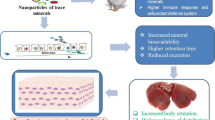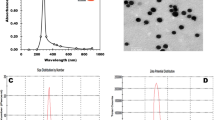Abstract
The purpose of this study was to investigate the renal and hepatic oxidative damage and toxicity caused by dietary high vanadium in broilers. A total of 420 one-day-old avian broilers were divided into six groups and fed on a corn–soybean basal diet as control diet (vanadium 0.073 mg/kg), and five high vanadium diets (vanadium 5 mg/kg, high vanadium group I; 15 mg/kg, high vanadium group II; 30 mg/kg, high vanadium group III; 45 mg/kg, high vanadium group IV; and 60 mg/kg, high vanadium group V) throughout the experimental period of 42 days. The results showed that the renal and hepatic superoxide dismutase (SOD) and glutathione peroxidase (GSH-Px) activities, ability to inhibit hydroxy radical, and malondialdehyde (MDA), glutathione, and vanadium contents were not significantly changed in high vanadium group I and II when compared with those of the control groups. However, the SOD and GSH-Px activities, ability to inhibit hydroxy radical, and GSH content were significantly decreased, and the MDA and vanadium contents were markedly increased in high vanadium groups III, IV, and V. At the same time, the lesions were also observed in the kidney and liver of high vanadium groups III, IV, and V. The renal tubular epithelial cells showed granular degeneration and vacuolar degeneration, and hepatocytes showed granular degeneration, vacuolar degeneration, and fatty degeneration. It was concluded that dietary vanadium in the range of 30–60 mg/kg could cause oxidative damage and vanadium accumulation, which induced renal and hepatic toxicity and lesions. The renal and hepatic function was finally impaired in boilers.








Similar content being viewed by others
References
Huang C, Ding M, Li J et al (2001) Vanadium-induced nuclear factor of activated T cells activation through hydrogen peroxide. Biol Chem 276:22397–22403
Ortiz-Bernad I, Anderson RT, Vrionis HA et al (2004) Vanadium respiration by Geobacter metallireducens: novel strategy for in situ removal of vanadium from groundwater. Appl Environ Microbiol 70:3091–3095
Byczkowski JZ, Wan B, Kulkarni AP (1988) Vanadium-mediated lipid peroxidation in microsomes from human term placenta. Bull Environ Contam Toxicol 41:696–703
Hopkins LL, Mohr HE (1974) Proceedings: vanadium as an essential nutrient. J Fed Proc 33:1773–1775
Sekar N, Li J, Yoram S (1996) Vanadium salts as insulin substitutes: mechanisms of action, a scientific and therapeutic tool in diabetes mellitus research. Crit Rev Biochem Mol 31(5):339–359
Domingo JL, Gomez M, Sanchez DJ et al (1995) Toxicology of vanadium compounds in diabetic rats: the action of chelating agents on vanadium accumulation. Mol Cell Biochem 153:233–240
Barceloux DG, Barceloux DD (1999) Vanadium. Clin Toxicol 37:265–278
Uthus EO (1995) Vanadium toxicity. In: Berthon G (ed) Metal ion toxicity. handbook of metal-ligand interactions in biological fluids, vol 2. Marcel Dekker, Inc., pp 730–734
Domingo JL, Llobet JM, Tomas JM et al (1985) Short-term toxicity studies of vanadium in rats. J Appl Toxicol 5:418–421
Paternain JL, Domingo JL, Gómez M et al (1990) Developmental toxicity of vanadium in mice after oral administration. J Appl Toxicol 10:181–186
Ousterhout LE, Berg LR (1981) Effects of diet composition on vanadium toxicity in laying hens. Poult Sci 60:1152–1159
Hill CH (1979) Studies on the ameliorating effect of ascorbic acid on mineral toxicities in the chick. J Nutr 109:501
Michael E, Carl LK (1987) Sodium vanadate toxicity in adult and developing rats role of peroxidative damage. Biol Trace Elem Res 14:193–208
Gutteridge JM (1995) Lipid peroxidation and antioxidants as biomarkers of tissue damage. Clin Chem 41(12):1819–1828
Keller RJ, Sharma RP, Grover TA et al (1988) Vanadium and lipid peroxidation: evidence for involvement of vanadyl and hydroxyl radical. Arch Biochem Biophys 265(2):524–533
Younes M, Albrecht M, Siegers CP (1984) Lipid peroxidation and lysosomal enzyme release induced by vanadate in vitro. Res Commun Chem Pathol Pharmacol 43(3):487–495
Lagerkvist BJ, Oskarsson A (2007) Vanadium. In: Nordberg GF (ed) Handbook on the toxicology of metals, vol 46. Springer, London, pp 905–923
Waters MD, Gardner DE, Aranyi C et al (1975) Metal toxicity for rabbit alveolar macrophages in vitro. Environ Res 9:32–47
Liu XD, Cui HM, Peng X et al (2011) The effect of dietary vanadium on cell cycle and apoptosis of liver in broilers. Biol Trace Elem Res. doi:10.1007/s12011-011-8993-1
Bradford MM (1976) A rapid and sensitive method for the quantitation of microgram quantities of protein utilizing the principle of protein-dye binding. Anal Biochem 72:248–254
Cui W, Cui HM, Peng X et al (2011) Effect of vanadium on the subset and proliferation of peripheral blood T cells, and serum interleukin-2 content in broilers. Biol Trace Elem Res 141:192–199
Zhang Z, Leonard S, Huang V C et al (2003) Evidence for intestinal oxidative stress in patients with obstructive jaundice. Free Radic Biol Med 34:1333–1342
Faverney C, Orsini N, de Sousa G et al (2004) Cadmium-induced apoptosis through the mitochondrial pathway in rainbow trout hepatocytes: involvement of oxidative stress. Aquat Toxicol 69:247–258
Stohs SJ, Bagchi D (1995) Oxidative mechanisms in the toxicity of metal ions. Free Radic Biol Med 18:321–336
Kalyani S P, Ramasarma VT (1992) Characterization of oxygen free radicals generated during vanadate-stimulated NADH oxidation. Mol Cell Biochem 111:33–40
Yang XG, Yang XD, Yuan L et al (2004) The permeability and cytotoxicity of insulin-mimetic vanadium compounds. Pharmacol Res 21:1026–1033
Maestro RD (1991) Free radicals as mediators of tissue injury. In: Dreosti IE (ed) Trace elements, micronutrients, and free radicals. Humana Press, USA
Zychlinski L, Byczkowski JZ, Kulkarni AP (1991) Toxic effects of long term intratracheal administration of vanadium pentoxide in rats. Arch Environ Contam Toxicol 20:295–298
Zaporowska H, Wasilewski W (1992) Haematological effects of vanadium on living organisms. Comp Biochem Physiol C 102:223–231
Aureliano M, Madeira VMC (1994) Interactions of vanadate oligomers with sarcoplasmic reticulum Ca2+-ATPase. BBA-Mol Cell Res 1221:259–271
Borges G, Mendonça P, Joaquim N et al (2003) Acute effects of vanadate oligomers on heart, kidney, and liver histology in the Lusitanian toadfish (Halobatrachus didactylus). Arch Environ Contam Toxicol 45:415–422
Soares SS, Aureliano M, Joaquim N et al (2003) Cadmium and vanadate oligomers effects on methaemoglobin reductase activity from Lusitanian toadfish: in vivo and in vitro studies. J Inorg Biochem 94:285–290
Hasspieler B, Behar J, Di-Giulio R (1996) Glutathione-dependent defense in channel catfish (Ictalurus punctatus) and brown bullhead (Ameriurus nebulosus). Ecotoxicol Environ Saf 28:82–90
Storey KB, Braz J (1996) Oxidative stress: animal adaptations in nature. Braz J Med Biol Res 29:1715–1733
Macara IG, Kustin K, Cantley LC Jr (1980) Glutathione reduces cytoplasmic vanadate mechanism and physiological implications. BBA-Gen Subjects 629:95–106
Pallor MS, Holdal JR, Ferris TF (1984) Oxygen free radicals in ischemic acute renal failure in the rat. J Clin Invest 74:1156–1164
Schaich KM (1992) Metals and lipid oxidation. Contemporary issues. Lipids 27:209–218
Valko M, Morris H, Cronin MTD (2005) Metals, toxicity and oxidative stress. Curr Med Chem 12:1161–1208
Gawel S, Wardas M, Niedworak E, Wardas P (2004) Malondialdehyde (MDA) as a lipid peroxidation marker. Wiad Lek 57:453–455
Kadiiska MB, Gladen BC, Baird DD et al (2005) Biomarkers of oxidative stress study II. Are oxidation products of lipids, protein and DNA markers of CCl4 poisoning? Free Radic Biol Med 38:698–710
Acknowledgment
This research was supported by the program for Changjiang scholars and the university innovative research team (IRT 0848), and the Education Department and Scientific Department of Sichuan Province (09ZZ017).
Author information
Authors and Affiliations
Corresponding author
Additional information
Juan Liu and Xiaodong Liu contributed equally to this work and should be considered as first authors.
Rights and permissions
About this article
Cite this article
Liu, J., Cui, H., Liu, X. et al. Dietary High Vanadium Causes Oxidative Damage-Induced Renal and Hepatic Toxicity in Broilers. Biol Trace Elem Res 145, 189–200 (2012). https://doi.org/10.1007/s12011-011-9185-8
Received:
Accepted:
Published:
Issue Date:
DOI: https://doi.org/10.1007/s12011-011-9185-8




